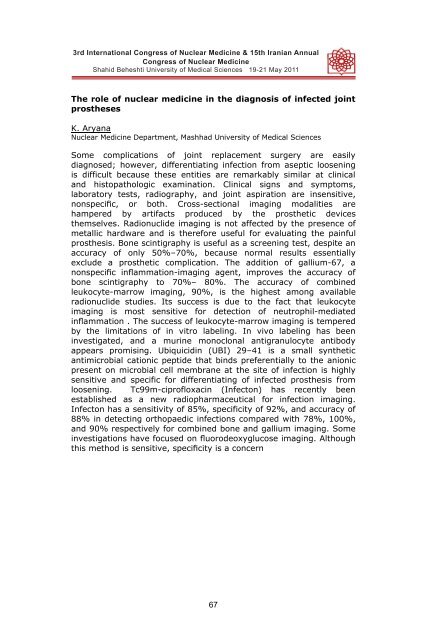Panel Disdussion
Panel Disdussion
Panel Disdussion
Create successful ePaper yourself
Turn your PDF publications into a flip-book with our unique Google optimized e-Paper software.
3rd International Congress of of Nuclear Medicine & & 15th 15th Iranian Annual Annual Congress of<br />
Congress of Nuclear Medicine<br />
Shahid Beheshti Shahid Beheshti University University of Medical of Medical Sciences Sciences 19-21 19-21 May May 2011<br />
The role of nuclear medicine in the diagnosis of infected joint<br />
prostheses<br />
K. Aryana<br />
Nuclear Medicine Department, Mashhad University of Medical Sciences<br />
Some complications of joint replacement surgery are easily<br />
diagnosed; however, differentiating infection from aseptic loosening<br />
is difficult because these entities are remarkably similar at clinical<br />
and histopathologic examination. Clinical signs and symptoms,<br />
laboratory tests, radiography, and joint aspiration are insensitive,<br />
nonspecic, or both. Cross-sectional imaging modalities are<br />
hampered by artifacts produced by the prosthetic devices<br />
themselves. Radionuclide imaging is not affected by the presence of<br />
metallic hardware and is therefore useful for evaluating the painful<br />
prosthesis. Bone scintigraphy is useful as a screening test, despite an<br />
accuracy of only 50%–70%, because normal results essentially<br />
exclude a prosthetic complication. The addition of gallium-67, a<br />
nonspecic inammation-imaging agent, improves the accuracy of<br />
bone scintigraphy to 70%– 80%. The accuracy of combined<br />
leukocyte-marrow imaging, 90%, is the highest among available<br />
radionuclide studies. Its success is due to the fact that leukocyte<br />
imaging is most sensitive for detection of neutrophil-mediated<br />
inammation . The success of leukocyte-marrow imaging is tempered<br />
by the limitations of in vitro labeling. In vivo labeling has been<br />
investigated, and a murine monoclonal antigranulocyte antibody<br />
appears promising. Ubiquicidin (UBI) 29–41 is a small synthetic<br />
antimicrobial cationic peptide that binds preferentially to the anionic<br />
present on microbial cell membrane at the site of infection is highly<br />
sensitive and specific for differentiating of infected prosthesis from<br />
loosening. Tc99m-ciprofloxacin (Infecton) has recently been<br />
established as a new radiopharmaceutical for infection imaging.<br />
Infecton has a sensitivity of 85%, specificity of 92%, and accuracy of<br />
88% in detecting orthopaedic infections compared with 78%, 100%,<br />
and 90% respectively for combined bone and gallium imaging. Some<br />
investigations have focused on uorodeoxyglucose imaging. Although<br />
this method is sensitive, specicity is a concern<br />
67
















